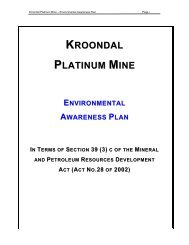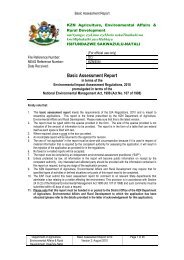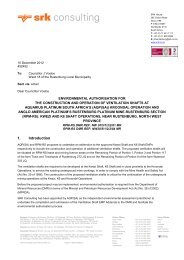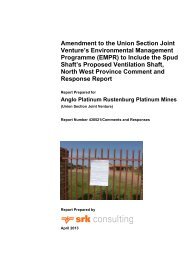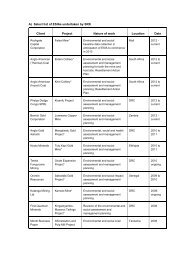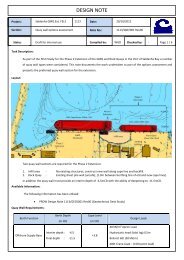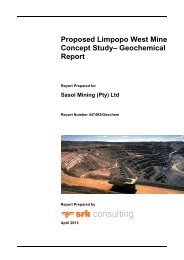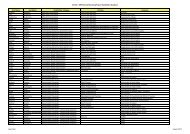Biodiversity (1 - SRK Consulting
Biodiversity (1 - SRK Consulting
Biodiversity (1 - SRK Consulting
Create successful ePaper yourself
Turn your PDF publications into a flip-book with our unique Google optimized e-Paper software.
dwelling) habitat. Very little arboreal and wetland-associated vegetation cover habitat<br />
occurs on the study site.<br />
Terrestrial habitat forms a large part of the study site and is of great ecological<br />
significance. Many mammal species have burrows or live almost permanently in the soil<br />
(Figure 29). The grassy plains are the most extensive habitat on site, characterised by<br />
the flat topography and red sandy surface, but with a mosaic of patches of grass and/or<br />
gravel (Figure 27). Most of these were found near the washes of the Koa River drainage<br />
system, but also extending up slopes to the feet of the various mountains and hills<br />
scattered across the landscape. The open plains grade into the red sand and dune<br />
fields. Very few termitaria or moribund termitaria, which are the preferred habitat for<br />
some mammal species, were found.<br />
The various rocky mountains (Windhoek, Hoedkop, Skelemberg) form prominent and<br />
well-defined habitats that support their own special biodiversity (Figure 30). These<br />
mountains and hills are an important habitat for rupiculous mammals.<br />
Although not obvious in dry conditions, during periods of exceptional rainfall there are<br />
watercourses that flow and pans that fill with water, supporting a range of unusual<br />
biodiversity (Figure 28). The Koa River wash with its associated pans are the most<br />
obvious. In the northeast corner of the study site a dam constructed by the mines<br />
provides permanent open water and relatively dense reeds and bushes, some of which<br />
overflow onto study site.<br />
Arboreal habitat is almost non-existent on the study site. A few Acacia species and<br />
other small trees and bushes occur scattered in the dunes. A few Quiver trees (Aloe<br />
dichotoma) occur on some of the mountain slopes.<br />
The 500 metres of adjoining zones along the study sites are similar to conditions<br />
described. The broader adjacent habitats are extensions of those present on site.<br />
79



